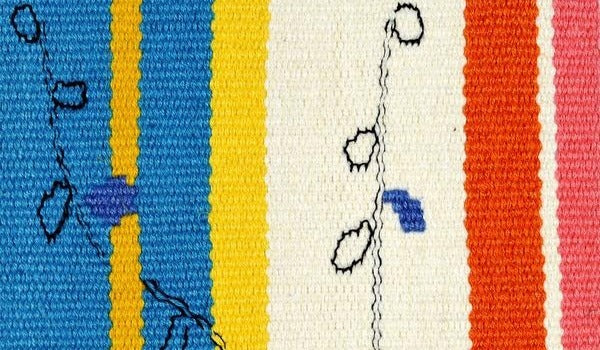
Embracing Colour

Fiona is an artist who doesn’t take her craft for granted. She knows her surroundings can impact on her work; she is aware that her moods and emotions may have influence, and she readily admits that she is always evolving.

The fact that she is embracing colour in all its resplendent glory in her work indicates that she is in a good place. Born in India to Glasgow-born parents, but returned to Scotland as a child. She studied English and History with Classical Studies at Newcastle in the early 1970s, but a love of drawing and weaving gnawed away at her, inspiring her to create rugs from the mid-1970s. She continued to weave rugs that sold through galleries, in between rearing her son and daughter, until tapestry entered her life in the early 1990s.
Self-taught, she has gone on to become one of the UK’s most successful tapestry artists, exhibiting throughout Britain, in Japan, Europe, Australia and the USA. Examples of her work are held in the collection of the V&A museum, the Arts Council and that of the Elgan apartment complex in Kobe, Japan. She is also much in demand for private and public commissions. Fiona is the first to admit that tapestry has gone through popularity phases, with companies such as the 100-year-old Dovecot Studios in Edinburgh aiding the current revival.

The term ‘tapestry’ should not be confused with embroidery, needlework or needlepoint – these techniques involve sewing into an existing fabric and decorating it with stitches. Tapestry is weaving the cloth and the image simultaneously at a loom by interlacing two sets of threads – the vertical warp and horizontal weft. Fiona weaves at a vertical loom frame – she has a range of different types from small wooden frames that prop against the table, to a builder’s scaffolding frame which she uses for large-scale commissions. She sketches her idea first and uses that as a guide behind the loom – with big tapestries she has to scale her drawings up.
“I use the Gobelins technique,” she says. “The wooden bobbin is the only tool I use along with my hands. I just use beautiful yarn and weave on an upright frame. The design takes a significant amount of time, as does scaling it up. I’ve always woven but in the early 1990s I realised that I wanted to create images in the weave through tapestry. My rugs were functional textiles, but with tapestry I started making pictures and smaller works that people wanted framed.”
“I had run out of steam with the rugs – I could see that I could start afresh with tapestry. It was liberating for me – my drawings could come to life. I had previously been afraid of colour and how to use it as I had been fairly conservative and mainly used earthy tones in my rugs. But when I started working with cotton and linen instead of wool, I really enjoyed it. The cotton and linen have a completely different feel work well with my designs. Now I use colours that I wouldn’t have put together – tapestry unleashed colour for me. Having said that, there is a limited palette and a theme in my work. I use a background colour and a few others that sing – too many and the colour is lost.”

"Tapestry is as simple as the alphabet but as complicated as the dictionary – it has a simplicity to it but you can start to take it down a more in-depth route. It can become more complicated – there is nothing simple about weaving a large tapestry.”
Extract from Jennifer Harper's article Crossover Artist from the Thread issue.
Fiona will be giving a one-day workshop in tapestry weaving on the 1 September 2018. The workshop will focus on the use of colour to create shapes, lines and texture in tapestry weaving, as well as looking at controlling tension and basic finishing techniques to make tapestry weaving simpler.
Blog post by Jessica Edney


1 comment
I love the clean, simple form of these wonderfully colored tapestries. Fresh. Thank you.